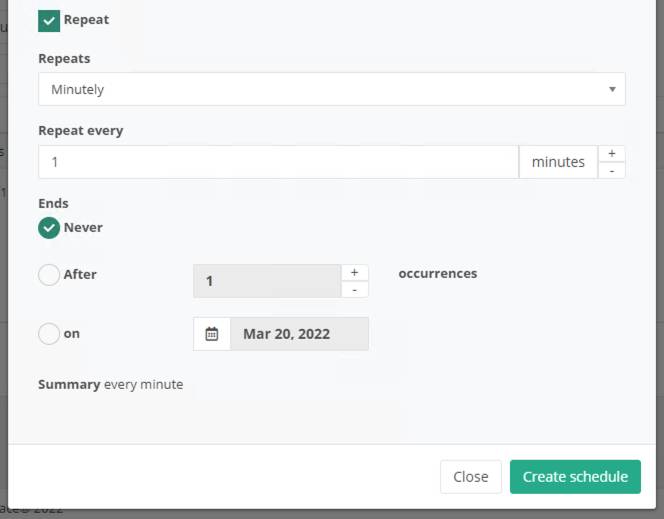Schedule RPA Process Availability
Learning Objectives
After completing this unit, you’ll be able to:
- Create RPA process schedules.
- Describe RPA process behavior during operating times.
Work with RPA Process Schedules
Before creating a schedule, it’s important to understand the behavior of an RPA process during a schedule. Look at the following example describing life as a customer service bot.
Imagine for a minute you’re a customer service bot for ACME. Your phone doesn’t have the ability to put customers on hold. When customers call, they either get through or need to call again later. Additionally, your schedule runs from 9 AM–5 PM. However, ACME’s policy states that you must continue working with a customer until their issue is resolved. You must also continue answering calls until the end of your shift. So if you answer a call at 4:55 PM and the customer’s issue takes 35 minutes to resolve, you finish at 5:30 PM. No one said that living life as a bot would be easy.
In summary, a bot’s work day at ACME is as follows.
- Begin work at 9 AM.
- Actively monitor the phone for incoming calls.
- When the phone rings, answer and help the customer until their issue is resolved.
- After the issue is resolved and if the time is between 9 AM–5 PM, return to monitoring the phone.
- When it’s outside of work hours and you aren’t on the phone, clock out.
All MuleSoft RPA bots operate like the customer service bot described in the previous scenario. As long as the RPA bot is available, it listens for the trigger of an RPA process. When the trigger condition is met, the RPA bot executes the RPA process. When it starts the RPA process, it must finish executing.
After the RPA bot finishes the process, it immediately resumes listening for the RPA process trigger condition. If the bot detects that it’s outside the RPA process schedule, and if it’s not executing a process, it suspends the process. The process remains suspended until the next scheduled run period.
Create an RPA Process Schedule
You configure an RPA process schedule using the Scheduling assistant dialog box when you create a run configuration as described in unit 2. Creating a schedule consists of two key steps: setting your initial run pattern and specifying if and how the pattern repeats.

Set the Initial Pattern
The initial pattern specifies both the duration of the run schedule and the first instance when the RPA process executes. In the Scheduling assistant dialog box, you set this pattern using one of the following methods.
| Initial Run Interval |
Description |
Example |
|---|---|---|
|
Specific interval |
Allows you to specify an exact date and time for your RPA process to start and end. Times are listed in 24-hour, 60-minute format. |
Mar 15, 2022, at 11:00 to Mar. 18 2022, at 11:00 |
|
All day |
Your RPA process starts at midnight on the first day and runs until midnight on the final day. |
Mar 15, 2022, to Mar 18, 2022 |
As a best practice, set the schedule for at least two minutes. Otherwise, there’s a risk that the RPA process won’t be triggered. RPA bots only check if an RPA process schedule has started once per minute.
Repeat the Initial Pattern
The Scheduling assistant dialog box allows you to schedule a bot to repeat the initial pattern. You specify how often the pattern should repeat and how much time should elapse before the pattern is repeated. You also specify an end time.

Let’s look at an example. Say you create an initial pattern with “Mar 10, 2022 10:00–Mar 10, 2022 10:02” and you set it to repeat every 5 minutes. The RPA bot runs the process for 2 minutes and repeats every 5 minutes. The 5 minutes are counted from the start of the first scheduled instance to the start of the next scheduled instance. This results in the RPA process running for 2 minutes followed by being on standby for three minutes and then repeating.

However, if the initial pattern is longer than the time between repetitions, the instances overlap. For example, if you create an initial pattern with “Mar 10, 2022 10:00–Mar 10, 2022 10:06” and you set it to repeat every 5 minutes, then the RPA process runs 24/7.

Understand the Impact of Service Times
Recall from unit 2 that when configuring an RPA bot, you specify what times it’s allowed to run. These service times take priority over process schedules. So if you have a process that’s scheduled to run from 10–11 AM every day, but the RPA bot service time is from 10:15–10:45 AM every day, the effective execution schedule for the process is from 10:15–10:45 AM every day.

In this unit, you learned how to create and configure an RPA process schedule. In the next unit, you learn about RPA bot sessions and how they’re used in production configurations.